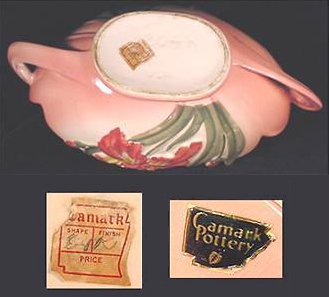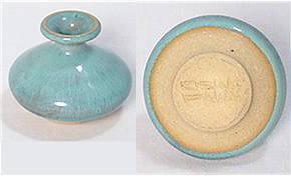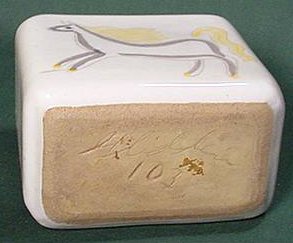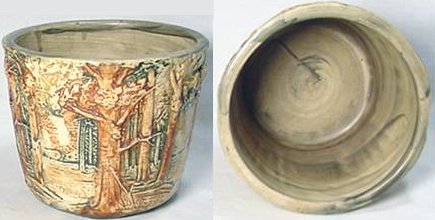Shopping for Vintage and Collectible American Pottery
[retrieved from https://www.cajunc.com/art-pottery-shopping]If you like to browse collectibles malls, garage sales, thrift shops or stop by estate sales, you've probably passed up pottery because you didn't know what to buy. Several elements make up a good pot. You don't have to know a lot to know enough to find bargains in every shop.
Here are some shopping techniques that will help you pick up some American pottery that may be valuable.

Check for Damage
Unless it's an outstanding piece, damaged pottery isn't a good buy.
- It's not easy to resell,
- is worth about half the value of an undamaged piece
- and won't increase in value quickly to make it a good investment.
There is no good reason to purchase damaged pots, unless you just love the shape, glaze, design or know that the pot is scarce. Don't start out buying damaged pottery; you'll soon have your shelves full of worthless "top-shelf" pots with the damage turned to the back.
Look for Quality

Very thick sides and heavy bottoms are characteristic of handmade pots from Pottery 101 class. They sometimes have a name scratched on the bottom.
These are pots to avoid.
Good American pottery comes in two basic forms — commercial production from a mold, and hand turned pieces.
- The molded production pieces shouldn't have major manufacturing flaws such as blobs of clay, rough seams or voids in the clay body. Attention to detail matters, even in commercial production.
- You can recognize hand turned pottery by checking for concentric circles that you can see or feel in the bottom.
Some pots are both commercial and hand turned pottery. Camark and Niloak made hand turned pottery for sale to the general public. Williamsburg pottery is a more recent example of commercial hand turned pottery.

Research the Name
If the piece is marked, use your handheld electronic device or a general antiques price guide like (affiliate link) Schroeder's Antiques Price Guide to check it out. If it's a well-known collectible pottery, you'll find it fast.
Some pots are marked with logos. For those, you'll need a book such as (affiliate link) Kovels' New Dictionary of Marks: Pottery and Porcelain, 1850 to the Present to identify the logo.
Some American pottery is unmarked. You may be able to identify pots by clay color from an article we wrote years ago, but updated recently.
Get an Education

Use antiques and collectibles malls, traveling antiques shows and seminars to accumulate a knowledge base to use for your American pottery search.
Books and the Internet are great sources of information but you can't learn the same things as you can at a live activity. You can feel the texture, the weight, the glaze -- all the qualities that make the pot unique.
You'll learn how to spot reproductions and how to identify unmarked pottery by checking out live events.
Buy Cheap

Cheap isn't a bad thing in American pottery. If you run onto a sale where the pottery is underpriced or everything is a dollar or two, buy the best pieces to study.
Once you get them home, you can look for similar pieces online and use them for your education. If you buy cheap and they're nothing of value, you can resell for the price you paid.
Buy Figurines and Uncommon

You won't know uncommon until you shop a few years, but eventually you'll single out pieces you've never seen before. You may not know what they are, but you'll know they're uncommon.
Figurines command a premium price in vintage and collectible American pottery.
- Unusual figurines may be animals such as goats, rhinos or hippos.
- Anthropomorphic figurines are animals doing human things, such as playing musical instruments or holding objects.
Study the price guides and collect shapes you like.
Look for Art

Hand painted pottery is often more valuable than a glazed pot. Commercial potteries used artists at the turn of the 20th century and produced outstanding work.

Learn the difference in a decal and hand painting by looking with a jeweler's loupe or a strong magnifying glass. You can see brush strokes on hand-painted pottery.
California became famous for hand painting on pottery in the 1940s, 1950s and even into the 1960s. Sascha Brastoff, Marc Bellaire and Matthew Adams did fine work.
New Jersey potters from that era who did handwork include Vontury and Cordey.
Dinnerware production was hand painted at Franciscan, Weller, Glidden, Blue Ridge and several others.
Rick Wisecarver was a potter and artist working in Ohio into the 1990s. His work is collectible for artistic merit.
Buy What You Like

Buy items you would use to decorate your home. Use them. Find a niche that you like and start a collection.
Learn as you go and buy expensive items only when you learn enough to make wise decisions. Even if you have money to spend, make your American pottery collecting a practice in financial restraint until you're sure you're making wise purchases.